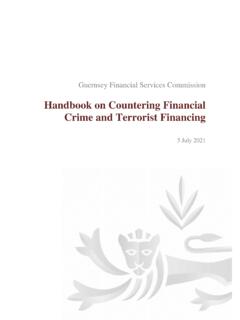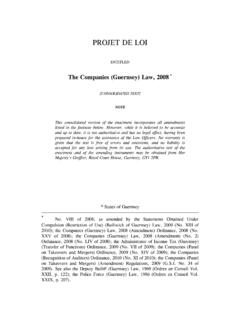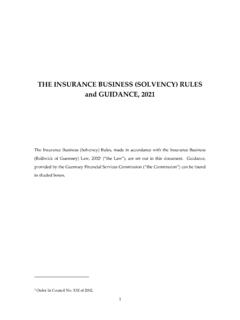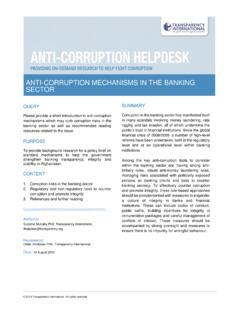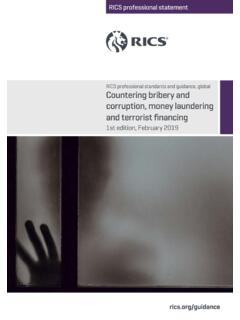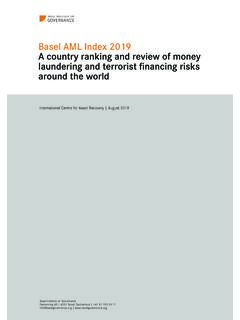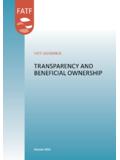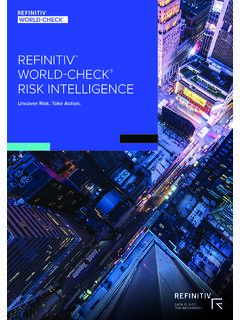Transcription of Handbook on Countering Financial Crime and Terrorist …
1 Guernsey Financial Services Commission Handbook on Countering Financial Crime and Terrorist Financing 13 June 2019. Contents Chapters of this Handbook Page Table of Acronyms 5. Table of Figures 7. Chapter 1 Introduction 9. Chapter 2 Corporate Governance 17. Chapter 3 Risk-Based Approach 31. Chapter 4 Customer Due Diligence 51. Chapter 5 Natural Persons 63. Chapter 6 Certification 71. Chapter 7 Legal Persons and Legal Arrangements 79. Chapter 8 Enhanced Customer Due Diligence 105. Chapter 9 Simplified Customer Due Diligence 127. Chapter 10 Introduced Business 139. Chapter 11 Monitoring Transactions and Activity 145. Chapter 12 UN, EU and Other Sanctions 153. Chapter 13 Reporting Suspicion 161. Chapter 14 Wire Transfers 177. Chapter 15 Employee Screening and Training 189. Chapter 16 Record Keeping 197.
2 Chapter 17 Transitional Provisions 203. Appendix A Glossary of Terms 209. Appendix B References 223. Appendix C Equivalent Jurisdictions 231. Appendix D Sector-Specific Guidance 233. Appendix E List of Domestic PEPs 253. Appendix F Introducer Certificate 257. Appendix G Schedule 3 to the Law 263. Index 311. Table of Acronyms The following acronyms are used within this Handbook . Where necessary definitions of these terms can be found in Appendix A. AML Anti- money laundering App Application BACS Bankers' Automated Clearing System CDD Customer Due Diligence CECIS Closed-Ended Collective Investment Scheme CFT Countering the Financing of Terrorism CIS Collective Investment Scheme CMP Compliance Monitoring Programme DT Drug Trafficking EC European Council ECDD Enhanced Customer Due Diligence ESAs European Supervisory Authorities EU European Union FATF Financial Action Task Force FIS Financial Intelligence Service FIU Financial Investigation Unit FSB Financial Services Business FT Financing of Terrorism GP General Partner IBAN International Bank Account Number IC Incorporated Cell ICC Incorporated Cell Company IFSWF International Forum of Sovereign Wealth Funds IMF International Monetary Fund IOSCO International Organization
3 Of Securities Commissions IT Information Technology LLP Limited Liability Partnership LP Limited Partnership LPP Legal Professional Privilege MI Management Information ML money laundering MLCO money laundering Compliance Officer MLRO money laundering Reporting Officer MONEYVAL The Committee of Experts on the Evaluation of Anti- money laundering and the Financing of Terrorism MSP money Service Provider MVTS money or Value Transfer Service NATO North Atlantic Treaty Organization NGCIS Non-Guernsey Collective Investment Scheme NPO Non-Profit Organisation NRA National Risk Assessment NRFSB Non-Regulated Financial Services Business Page 5. OECD Organisation for Economic Co-operation and Development OECIS Open-Ended Collective Investment Scheme OFAC Office of Foreign Assets Control PB Prescribed Business PC Protected Cell PCC Protected Cell Company PEP Politically Exposed Person PQ Personal Questionnaire PSP Payment Service Provider RFID Radio-Frequency Identification SCDD Simplified Customer Due Diligence SDN Specially Designated National SIO Senior Investigating Officer SWF Sovereign Wealth Fund SWIFT Society for Worldwide Interbank Financial Telecommunication THEMIS The FIS Online Reporting Facility for a Disclosure of Suspicion UK United Kingdom UN United Nations UNSCR United Nations Security Council Resolutions US United States of America Page 6.
4 Table of Figures The following tables and diagrams are used within this Handbook : Page Fig. 1 CDD Measures for Key Principals 54. Fig. 2 Process of Certification 72. Fig. 3 Chains of Certification 77. Fig. 4 Flow of Copy Certified Documentation 77. Fig. 5 Three Step Test of Beneficial Ownership 85. Fig. 6 Control Through Other Means 87. Fig. 7 Direct Holding vs. Indirect Holding 88. Fig. 8 Beneficial Ownership of PCCs 90. Fig. 9 Limited Partnership 92. Fig. 10 Enhanced Measures Flowchart 107. Fig. 11 Application of Due Diligence and Enhanced Measures Depending on Risk 108. Fig. 12 Timescales for Declassification of PEPs 117. Page 7. Chapter 1. Introduction Contents of this Chapter Introduction .. 10. Background and 10. The Bailiwick's AML and CFT 11. Handbook Purpose .. 12. Requirements of Schedule 3.
5 13. Structure and Content of the Handbook .. 13. Significant Failure to Meet the Required Standards .. 14. Data 14. The Financial Action Task Force .. 14. The National Risk Assessment .. 15. MONEYVAL .. 15. Introduction 1. The laundering of criminal proceeds, the financing of terrorism and the financing of the proliferation of weapons of mass destruction (henceforth referred to collectively as ML and FT ) through the Financial and business systems of the world is vital to the success of criminal and Terrorist operations. To this end, criminals and terrorists seek to exploit the facilities of the world's businesses in order to benefit from such proceeds or financing. 2. Increased integration of the world's Financial systems and the removal of barriers to the free movement of capital have enhanced the ease with which criminal proceeds can be laundered or Terrorist funds transferred and have added to the complexity of audit trails.
6 The future of the Bailiwick of Guernsey ( the Bailiwick ) as a well-respected international Financial centre depends on its ability to prevent the abuse of its Financial services business ( FSB ) and prescribed business ( PB ) sectors by criminals and terrorists. Background and Scope 3. The Bailiwick authorities are committed to ensuring that criminals, including money launderers, terrorists and those financing terrorism or the proliferation of weapons of mass destruction, cannot launder the proceeds of Crime through the Bailiwick or otherwise use the Bailiwick's finance and business sectors. The Guernsey Financial Services Commission ( the Commission ). endorses the International Standards on Combating money laundering and the Financing of Terrorism & Proliferation issued by the Financial Action Task Force ( FATF and the FATF.)
7 Recommendations ). This Handbook is a statement of the standards expected by the Commission of all specified businesses in the Bailiwick to ensure the Bailiwick's compliance with the FATF. Recommendations. 4. Should a specified business assist in laundering the proceeds of Crime or in the financing of a Terrorist act or organisation, it could face regulatory investigation, the loss of its reputation, and law enforcement investigation. The involvement of a specified business with criminal proceeds or Terrorist funds would also damage the reputation and integrity of the Bailiwick as an international finance centre. 5. Under Section 1(1) of the Criminal Justice (Proceeds of Crime ) (Bailiwick of Guernsey) Law, 1999 as amended ( the Law ) all offences that are indictable under the laws of the Bailiwick are considered to be predicate offences and therefore funds or any type of property, regardless of value, acquired either directly or indirectly as the result of committing a predicate offence, are considered to be the proceeds of Crime .
8 Under Bailiwick law all offences are indictable, with the exception of some minor offences which mainly concern public order and road traffic. The range of predicate offences is therefore extremely wide and includes, but is not limited to, the following: (a) participation in an organised criminal group and racketeering;. (b) terrorism, including FT;. (c) financing of proliferation of weapons of mass destruction;. (d) human trafficking and migrant smuggling;. (e) sexual exploitation, including sexual exploitation of children;. (f) illicit trafficking in narcotic drugs and psychotropic substances;. (g) illicit arms trafficking;. (h) illicit trafficking in stolen and other goods;. (i) corruption and bribery;. (j) fraud and tax evasion;. (k) counterfeiting and piracy of products;. (l) environmental Crime .
9 (m) murder, manslaughter and grievous bodily injury;. Chapter 1 - Page 10. (n) kidnapping, illegal restraint and hostage taking;. (o) robbery and theft;. (p) smuggling;. (q) extortion;. (r) forgery;. (s) piracy; and (t) insider trading and market manipulation. 6. The Bailiwick's anti- money laundering ( AML ) and Countering the financing of terrorism ( CFT ) legislation (and by extension this Handbook ) applies to all specified businesses conducting business in the Bailiwick. This includes Bailiwick-based branches and offices of companies incorporated outside of the Bailiwick conducting Financial services and/or prescribed business within the Bailiwick. In this Handbook all references to the firm' shall have the same meaning as specified business in Paragraph 21(1) of Schedule 3, and includes all such businesses whether natural persons, legal persons or legal arrangements, including but not limited to, companies, partnerships and sole traders.
10 7. Schedule 3 to the Law (referred to henceforth as Schedule 3 ) and this Handbook have been drafted to take into account the fact that not all of the requirements of the FATF. Recommendations are relevant to all businesses. In this regard, while certain provisions (for example, the application of a risk-based approach, corporate governance, customer due diligence ( CDD ), suspicion reporting, employee training and record keeping) apply equally to all firms, there are other requirements set out in this Handbook which may not be as relevant to some particular areas of industry (for example, wire transfers). Taking such an approach to the drafting of Schedule 3 and this Handbook is intended to prevent the application of unnecessary and bureaucratic standards. The Bailiwick's AML and CFT Framework 8.
